Vascular Plants of the Gila Wilderness
Presented in Association with the
Western New Mexico University Department
of Natural Sciences
Phoradendron villosum (Nuttall) Nuttall ex Engelmann subsp. coryae (Trelease) Wiens
(Oak Mistletoe, Cory's Mistletoe)
Family: Viscaceae
Status: Native
Synonyms:
Phoradendron coryae Trelease
Phoradendron flavescens (Pursh) Nuttall var. pubescens Engelmann
Phoradendron havardianum Trelease
Phoradendron villosum Nuttall
Phoradendron villosum Nuttall subsp. coryae (Trelease) Wiens
Phoradendron serotinum (Rafinesque) M.C. Johhston subsp. tomentosum (de Candolle) Kuijt
Phoradendron villosum subsp. coryae is one of the most common mistletoes found in the Gila National Forest, generally found parasitizing oak trees. The leaves are up to about 2 cm in length, a bit shorter than those of P. leucocarpum. The leaves are oval and puberulent. The fruit is white and spherical. The fruit consists of a thin outer covering and a sticky gelatinous interior that surrounds the small single seed which is slightly hairy and shaped like a turnip. The modified roots which penetrate the host tissue are called "haustoria."
While the inflorescences of P. coryae (and other mistletoes as well) are easy to locate, it is more difficult to see their details. Mostly, the individual flowers and their parts are just inconspicuous. In P. villosum subsp. coryae, all flowers on a given plant are either all male or all female (dioecious).
Both staminate (male) and carpellate (female) flowers have 3 small, triangular yellowish green tepals. At the base of each tepal in the staminate flowers is a sessile anther (lacking the filament present in the usual stamen) with 2 locules that open by longitudinal slits.
The carpellate flowers have an inferior ovary with a sessile, punctate stigma surrounded by a glandular nectar disc. The ovules are undifferentiated. The fruit is a single seeded berry-- interestingly with one cotyledon (but not a monocot!) and green endosperm.
Please click on an image for a larger file.
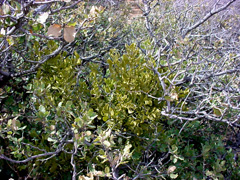
Phoradendron villosum subsp. coryae, photo Russ Kleinman, Burro Mtns., Monarch Canyon, Mar. 4, 2006
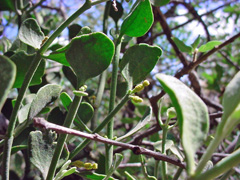
Phoradendron villosum subsp. coryae, flowering, photo Russ Kleinman, Pinos Altos Range, Pinos Altos, Oct. 10, 2007
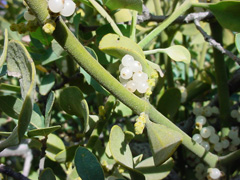
Phoradendron villosum subsp. coryae, with fruit, photo Russ Kleinman, Silver City, Nov. 7, 2007
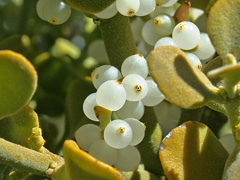
Phoradendron villosum subsp. coryae, with fruit, photo Russ Kleinman, Pinos Altos Range, CD Trail above the Arrastra, Oct. 21, 2008
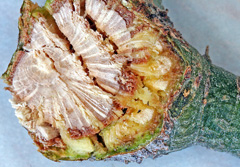
Phoradendron villosum subsp. coryae, haustoria at junction of host and parasite tissue, photo Russ Kleinman, Pinos Altos Range, Pinos Altos, Dec. 24, 2008
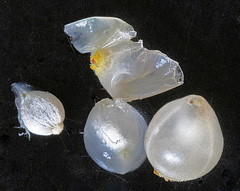
Phoradendron villosum subsp. coryae, 1x macro of entire berry on right, outer covering above the gelatinous interior in center, and bare seed on left, photo Russ Kleinman, Pinos Altos Range, Pinos Altos, Jan. 3, 2009
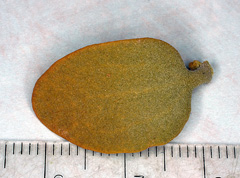
Phoradendron villosum subsp. coryae, closeup of leaf, photo Russ Kleinman, Pinos Altos Range, Pinos Altos, December 8, 2009
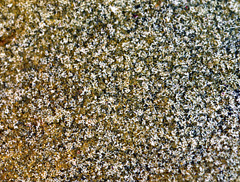
Phoradendron villosum subsp. coryae, 3x macro of adaxial surface leaf which is densely puberulent on both surfaces, photo Russ Kleinman, Pinos Altos Range, Pinos Altos, December 8, 2009
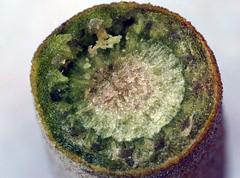
Phoradendron villosum subsp. coryae, macro of cross-section of stem, photo Russ Kleinman, Pinos Altos Range, Pinos Altos, December 8, 2009
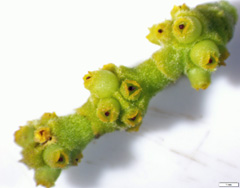
Phoradendron villosum subsp. coryae, carpellate inflorescence with individual flowers in various stages of fruit development, photo Russ Kleinman, Pinos Altos Range, Pinos Altos, February 3, 2018
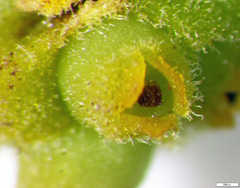
Phoradendron villosum subsp. coryae, single carpellate flower with inferior ovary developing into a berry, and punctate stigma, photo Russ Kleinman, Pinos Altos Range, Pinos Altos, February 3, 2018
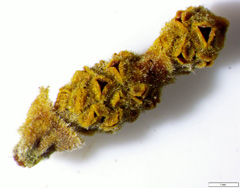
Phoradendron villosum subsp. coryae, staminate inflorescence, photo Russ Kleinman, Pinos Altos Range, Pinos Altos, February 3, 2018
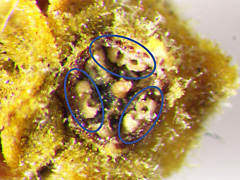
Phoradendron villosum subsp. coryae, single staminate flower with all 3 tepals removed revealing a sessile 2-locular anther at the base of each tepal (each anther circled in blue, all have already dehisced and released pollen), photo Russ Kleinman, Pinos Altos Range, Pinos Altos, February 3, 2018
Back to the Index












